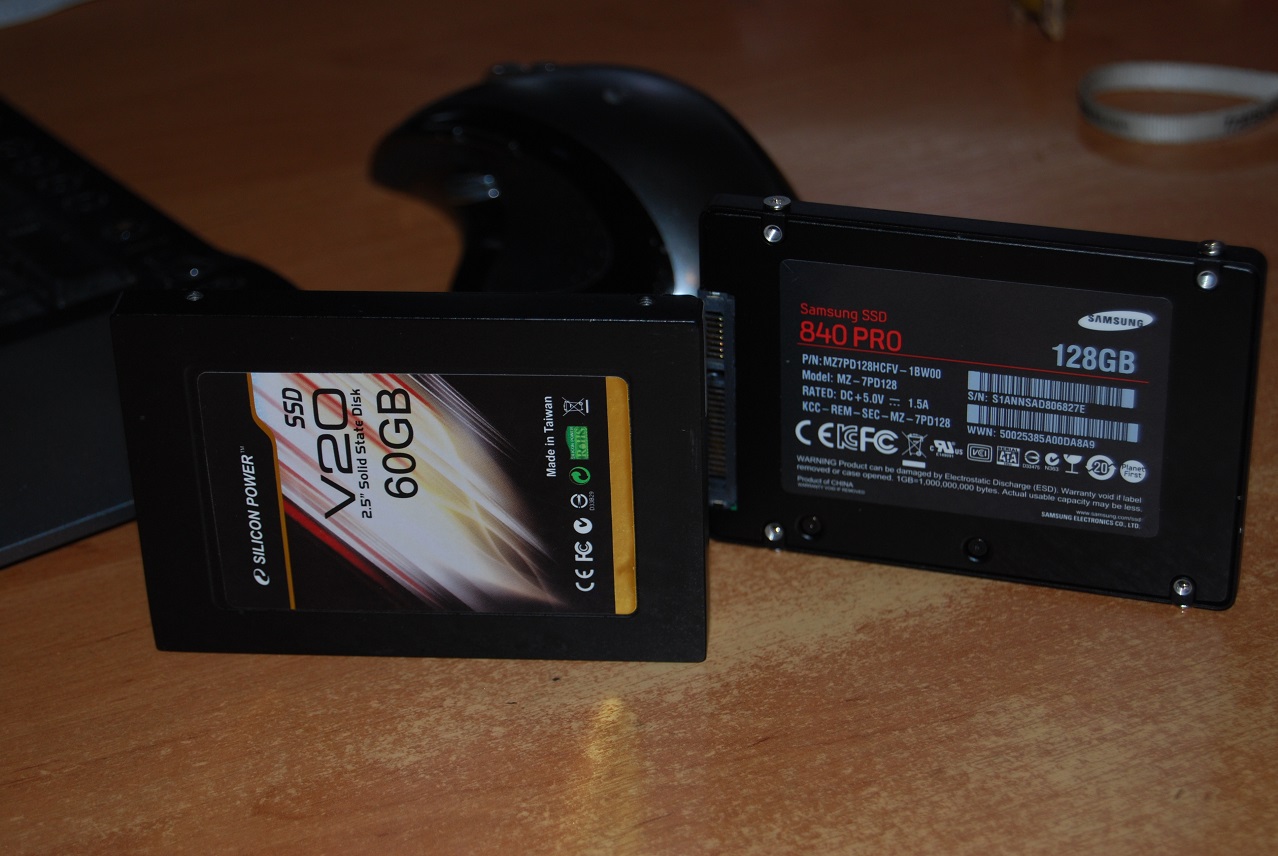SSD screw turns off after 5 minutes of operation Or the unthinkable logic of the SSD controller
Background
I have a computer. And it stands on it SSD hard drive Silicon Power SSD 60GB.
WINDOWS 8 is installed on this SSD. Everything is done intelligently: TRIM is enabled, all cache files, registry, user profiles, etc. transferred to 2Tb of the “mechanical hard drive”. He lived for a year at not "grieve". The system loaded quickly, the programs did not think ... He will
live on such a configuration for a long time.

Beauty.
Start
The day before yesterday I bought another SSD-drive: Samsung SSD 840 Pro 128Gb. I decided to pump slightly - about two times that way.

Here are both handsome.
To update. I decided to use Samsung's proprietary program - Data Migration. Downloaded the latest version, installed. The new SSD did not connect, but “drove” the computer into Sleep ...
And went to sleep.
Death
In the morning with a run, I turned on the computer, checked mail and Skype. For everything about all 2 minutes. And went to work. Comp left to live his life ... In the

evening he arrived. I look at the computer hanging immediately after the BIOS initialization of devices in the boot state of the system. I went into the BIOS. It turned out that the system was trying to boot from a photo flash drive, on which naturally it was not installed. Changed the boot order ... The computer booted. Everything seems to be good. But after 5 minutes, Windows 8 crashed, crashed into BSOD and restarted the computer.
Silicon Power SSD is not defined as "bios".
Funeral service
After a complete power outage and distortion of the loops, the SSD came to life. The system has booted. But she lived exactly 5 minutes, and BSOD ... The
whole evening there were dances with a tambourine:
- The screw was connected to another computer;
- I tried to make a copy of the partitions on a new screw;
- Tried to create an image of partitions;
- I flashed the screw with different firmware;
- He didn’t even do anything.
But as soon as 5 minutes passed, the SSD fell off. It just disappeared from the devices or disconnected if it was under DOS.
You cannot bury
I’m calling my friends for a service. I want to put a comma in the title. They say: “We kill such SSDs and change them under warranty.”
So all the same, he died. Bury!
I move the files manually. 5 minute sessions.
At the stage of moving, a strange file was found, deep in the subfolders of the Users folder. The strange thing about this file was one - the name was too long, very similar to the script code. He did not want to either retire or copy. Skipping this file, I moved everything else. Through the console, deleted the Users folder with the command
rd /s/q Users, along with a strange file. Just in case, just in case. ... And 10 minutes passed. Then I 8 minutes “Wipe zero” free space ... 20 minutes have passed , the SSD is working.
Strange!
He is dead YESor NO . Or the information recorded on the SSD affects the SSD itself. But no one accessed that ill-fated file, especially under DOS. By what side can it affect the operation of the drive, just being on it. Impossible! But the indisputable fact is that:
A file with a strange long name similar to a script code that simply resides on an SSD may disable its controller. There is no need to even contact him.
Unthinkable logic. Most likely, it is enough that the data from the name of this file passes through the controller when updating control records for disk layout. I think it took 5 minutes to complete this process.
HURRY FRIENDS ... Now the information in the stone affects the stone itself.
Resurrection
I uploaded the moved files back. Connected SSD to the native computer. The system lives on.
5 minutes.
10 minutes.
5:00.
And I am writing my first article on Habrahabr ...
Exposure
But where did this file come from? Is there really a virus or backdoor?
But when did this happen? Once Data Migration was installed ... Or is it a coincidence?
Maybe the drive manufacturer knows about this possibility?
I really want to read the opinion of the Habr community.
I would like to see the full name of that ill-fated file that was so suddenly deleted by me. It began with "0" (zero).
